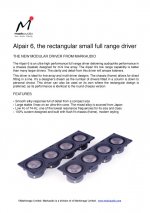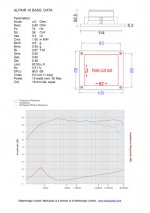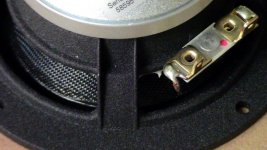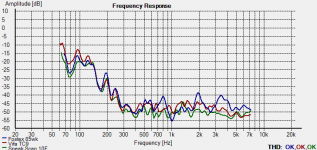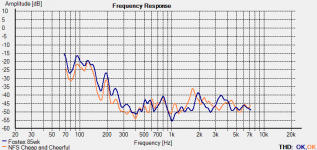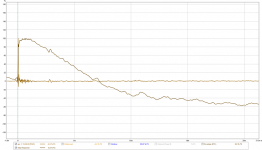Yes indeed. We share a similar goal. For me, the "you are there" effect is what it's all about. 

OK, and by the way, those little A3 drivers. I think there's still one or two on my self somewhere. Nicely built unit. High retail price. I happen to know the factory price and it was nowhere near retail. I'll take the Vifa, thank you.


OK, and by the way, those little A3 drivers. I think there's still one or two on my self somewhere. Nicely built unit. High retail price. I happen to know the factory price and it was nowhere near retail. I'll take the Vifa, thank you.
I can agree to that, fluid, that was my line of thought as well. Though I have thought about the way the arrays load those low frequencies, basically spreading them out over a long vertical and thin horizontal area. It seems to work well to get an even response out in the room.
I am wondering how 2 subs would do in comparison. I'd use them together with the lines, by scaling down what I ask the lines to do.
Fun to read about your plans though, I hope you'll document that journey for us to follow.
I will do my best to document what I do although it won't be to the same extent as you
This is a start, I have the amp and DAC ready though.
There is a good explanation and design on small box subwoofers from Linkwitz.
Pluto + subwoofer
Three or four of those spread around the room in a Geddes style multisub arrangement would be easy to hide and would be able to work with the room rather than against it. Similar to how the lines can excite the room more evenly due to the length.
I have an LX521 dipole system that uses 4 x 10" Seas woofers. These can produce some serious amounts of low bass but they do need to be placed correctly to work at their best. They do need room to breathe so I doubt they will be accepted as a solution.
There was a discussion related to the 'speed' of woofers that I read fairly recently. There is obviously a difference in the ability of a speaker to react to input based on it's moving mass and the suspension type that is used. Light cones and cloth surrounds are better in this regard. Heavy sub woofer type cones with big rubber suspensions for huge xmax not so much.
I think the confusion comes because if you were to use a big woofer as both bass and midrange like in an econowave/seos type design then the woofer is going to be producing both the fundamental and parts and the harmonics of bass drums etc. If you using a true subwoofer for the absolute lowest frequencies then it is irrelevant as even the biggest heaviest cone can react within the time needed to produce the lowest notes.
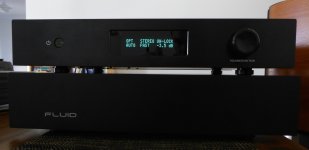
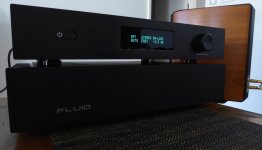
Would these have been suitable drivers? Price was between Scan Speak and Vifa. The still available round version is about US $56.
Not sure why second image has Alpair 10 Bass Data on it, as it is definitely the Alpair 6 rectangular data set.
Not sure why second image has Alpair 10 Bass Data on it, as it is definitely the Alpair 6 rectangular data set.
Attachments
Last edited:
Slow and Fast Bass
"Slow" or "fast" bass are descriptions of how much bass there is relative to other frequencies. There are no slow or fast drivers. If a driver is producing a certain frequency and a certain SPL, it has to move and accelerate at fixed rates (for a given area or displacement).
Often when people say that "the bass is fast" what they are really reacting to is there is too little bass. And conversely, too much bass sounds slow. You can try this by adding back a certain part of the signal back into the main signal. For example, if you add everything below 100 Hz back into your music, you will have raised the level of the bass relative to other frequencies and you might notice the music got "slower."
Good bass can come from seperate subs or from an array of small drivers. You just need enough SPL capability.
"Slow" or "fast" bass are descriptions of how much bass there is relative to other frequencies. There are no slow or fast drivers. If a driver is producing a certain frequency and a certain SPL, it has to move and accelerate at fixed rates (for a given area or displacement).
Often when people say that "the bass is fast" what they are really reacting to is there is too little bass. And conversely, too much bass sounds slow. You can try this by adding back a certain part of the signal back into the main signal. For example, if you add everything below 100 Hz back into your music, you will have raised the level of the bass relative to other frequencies and you might notice the music got "slower."
Good bass can come from seperate subs or from an array of small drivers. You just need enough SPL capability.
Wow, does this thread cover ground...
Thanks both fluid and Brytt for your suggestions:
I do have balanced capacity on my Buffalo DAC, and I like the concept behind balanced designs. But, as fluid mentions, I like that my first One amp is completed. If it turns out I need a larger Amp I would prefer to build a Large Version and use my current Medium for surround. Or if Kindhornman designs that coaxial full-range driver, I would need the Medium for that...
For a lower impedance, I could wire a 30/cabinet array (5 in series/6 sets in parallel) to 6.66 ohms, or better yet a 28/cabinet array (4 in series/7 sets in parallel) to 4.5 ohms...
In my case, I am wondering what low bass from such a low moving mass sounds like compared to the subs. I finally figured out a way to run my Buffalo thru the clock on M-Audio DAC, via SPDIF. So I use one channel on the M-Audio for the subs and Buffalo for the mains. The sound of this arrangement is a little leaner, so apparently source clocks do make a difference, although it is very, very, very small. It did not negatively affect the mid-range or wide soundstage, so I am happy. What I can say, is with my current arrays, the subs are definitely needed. My arrays full-range are all distortion below 80 Hz, but I would attribute this to the poor cabinets before I accuse the drivers themselves. I think they could do better with better cabinets. I will not be messing around with the Vifa build. As CraigSu mentioned, it is all to easy to have an ugly experiment be a main system for a long time, I am going on about three years with mine.
Bear in mind, the 10F needs to be modified for close driver to driver spacing in the array, as in cutting the bezels... For a moment, I thought You would lose the screw hole too, but You don't. Considering this is a $90 unit, it is a shame to have to expend so much labor...
The A3 was the $120 driver I was thinking kindhornman could out perform and undersell.
Even at $90, kindhornman's design could have the edge over the 10F mainly in labor saving costs due to the design issue I mention above.
The distortion measurements of the Vifa are very impressive, outperforming my NSBs and the Fostex FF85wk. The 10F was slightly better with the measurements I took, although I would not consider myself a professional. Yet it is nice to see that I my measurements were in the ball park of what is published, even with my moderate set-up.
Now back to work...
(I will more then likely disappear again, so I will see You all when time permits...)
Thanks both fluid and Brytt for your suggestions:
What you mention there is all true and good information but is not so easy as an upgrade path for Allen, as you need to double the heatsink which is basically a new chassis. Wiring the speakers to present a 4 ohm load will allow the maximum the amplifier can give and the existing heatsink should be enough as maximum power will only really be used for peaks.
I do have balanced capacity on my Buffalo DAC, and I like the concept behind balanced designs. But, as fluid mentions, I like that my first One amp is completed. If it turns out I need a larger Amp I would prefer to build a Large Version and use my current Medium for surround. Or if Kindhornman designs that coaxial full-range driver, I would need the Medium for that...
For a lower impedance, I could wire a 30/cabinet array (5 in series/6 sets in parallel) to 6.66 ohms, or better yet a 28/cabinet array (4 in series/7 sets in parallel) to 4.5 ohms...
Open for debate is the fact that my moving mass is 65 gram currently. With the SD area of a 15/16" woofer. Would a sub (or 2 or 3) be sluggish? Even if it only has to do 20 to 40 HZ?
In my case, I am wondering what low bass from such a low moving mass sounds like compared to the subs. I finally figured out a way to run my Buffalo thru the clock on M-Audio DAC, via SPDIF. So I use one channel on the M-Audio for the subs and Buffalo for the mains. The sound of this arrangement is a little leaner, so apparently source clocks do make a difference, although it is very, very, very small. It did not negatively affect the mid-range or wide soundstage, so I am happy. What I can say, is with my current arrays, the subs are definitely needed. My arrays full-range are all distortion below 80 Hz, but I would attribute this to the poor cabinets before I accuse the drivers themselves. I think they could do better with better cabinets. I will not be messing around with the Vifa build. As CraigSu mentioned, it is all to easy to have an ugly experiment be a main system for a long time, I am going on about three years with mine.
The fiberglass Vifa version is quite comparable but I wouldn't want to pick the winner between the TC and TG. The Kevlar coned family member was an interesting driver but from what I've seen it wasn't bettering the TC9. At least not in the measurements I have seen.
When Vifa was split up from Scan Speak the 10F was born.
Bear in mind, the 10F needs to be modified for close driver to driver spacing in the array, as in cutting the bezels... For a moment, I thought You would lose the screw hole too, but You don't. Considering this is a $90 unit, it is a shame to have to expend so much labor...
The A3 was the $120 driver I was thinking kindhornman could out perform and undersell.
Even at $90, kindhornman's design could have the edge over the 10F mainly in labor saving costs due to the design issue I mention above.
The distortion measurements of the Vifa are very impressive, outperforming my NSBs and the Fostex FF85wk. The 10F was slightly better with the measurements I took, although I would not consider myself a professional. Yet it is nice to see that I my measurements were in the ball park of what is published, even with my moderate set-up.
Now back to work...
(I will more then likely disappear again, so I will see You all when time permits...)
Attachments
Last edited:
wrong picture....
Had the 10f bezel on my mind...
Here are the distortion measurements between the Vifa, 10F, FF85wK and NSB (or NFS): ???Is it "No stinking Badges" or "Not For Sale" for my current drivers???
Bear in mind the drivers were mounted on a 18" x 32" panel, which resulted in a natural roll-off around 300 Hz...
Had the 10f bezel on my mind...
Here are the distortion measurements between the Vifa, 10F, FF85wK and NSB (or NFS): ???Is it "No stinking Badges" or "Not For Sale" for my current drivers???
Bear in mind the drivers were mounted on a 18" x 32" panel, which resulted in a natural roll-off around 300 Hz...
Attachments
Last edited:
Fluid,
Did I miss a post somewhere? What are those DAC and amp? DIY?
Maybe, they are certainly DIY. The DAC is a kit but I changed quite a few components.
http://www.diyaudio.com/forums/digital-line-level/299896-lks-audio-es9018-dac-kit-build.html
Amp is my First One Stereo build, pics and a bit more info here
http://www.diyaudio.com/forums/vendors-bazaar/248996-first-one-mosfet-amplifier-module-341.html#post4878617
Had the 10f bezel on my mind...
Here are the distortion measurements between the Vifa, 10F, FF85wK and NSB (or NFS): ???Is it "No stinking Badges" or "Not For Sale" for my current drivers???
Bear in mind the drivers were mounted on a 18" x 32" panel, which resulted in a natural roll-off around 300 Hz...
Isn't it amazing to see that Vifa almost keep up with the 10F?
I will do my best to document what I do although it won't be to the same extent as you
This is a start, I have the amp and DAC ready though.
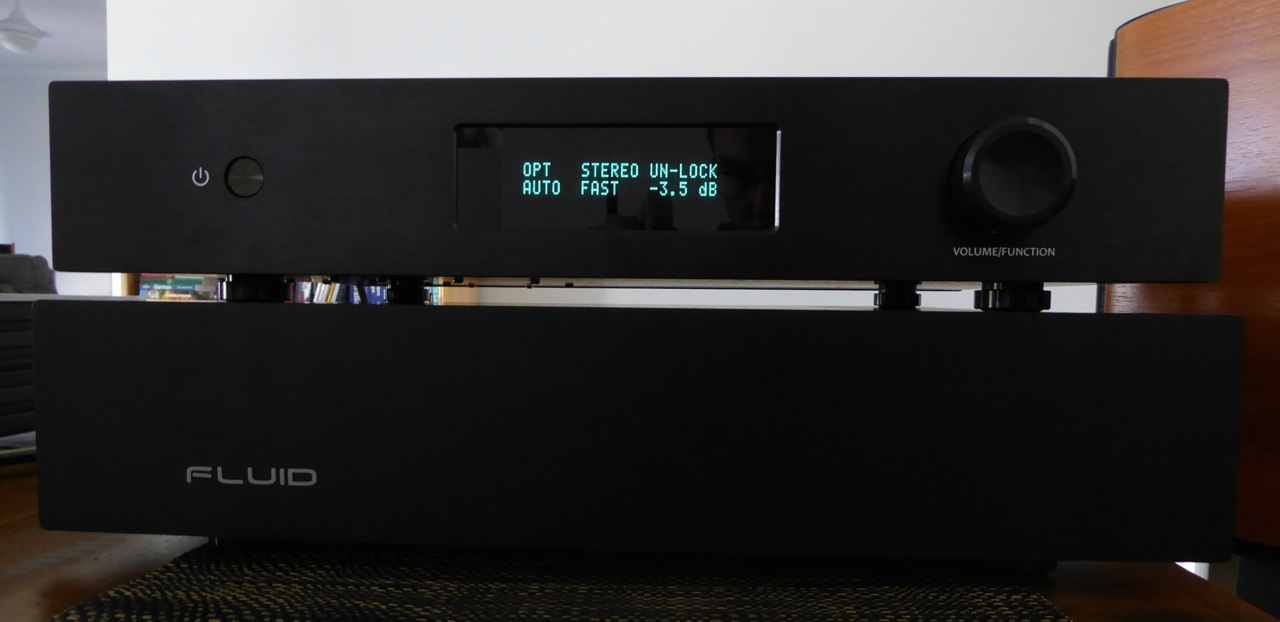
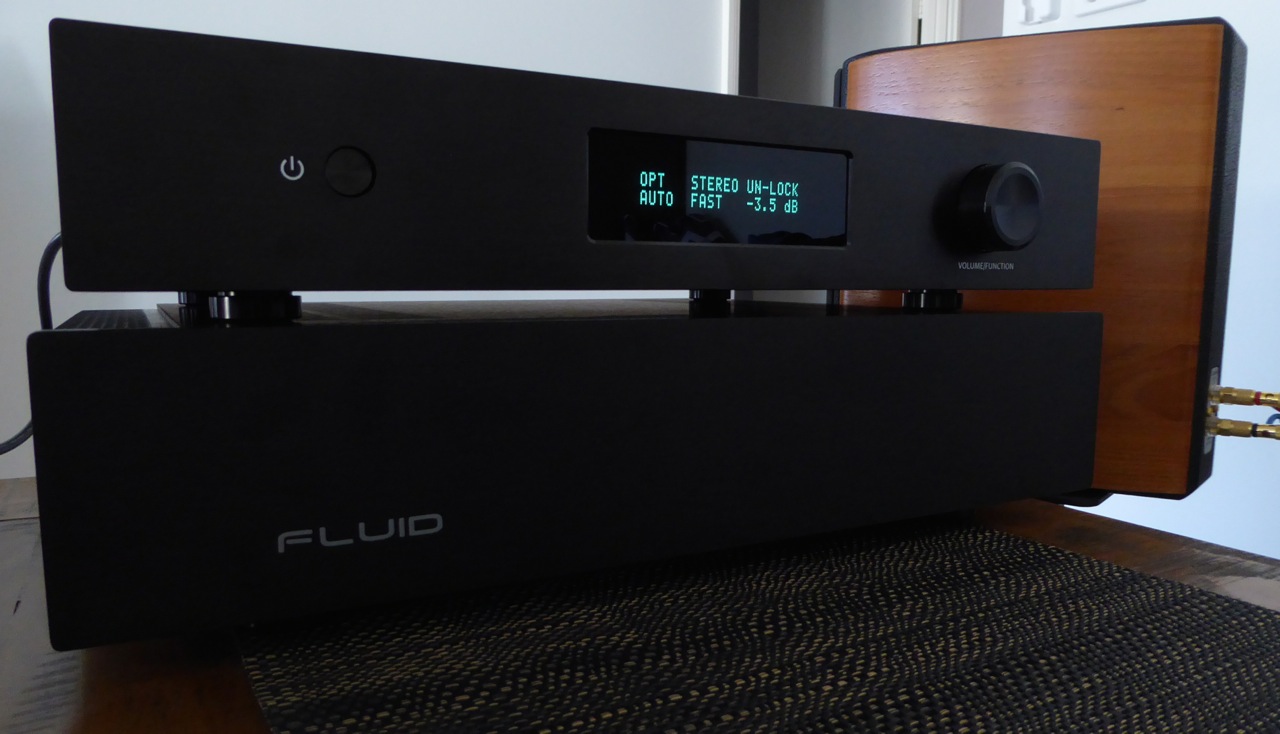
There is a good explanation and design on small box subwoofers from Linkwitz.
Pluto + subwoofer
Three or four of those spread around the room in a Geddes style multisub arrangement would be easy to hide and would be able to work with the room rather than against it. Similar to how the lines can excite the room more evenly due to the length.
I have an LX521 dipole system that uses 4 x 10" Seas woofers. These can produce some serious amounts of low bass but they do need to be placed correctly to work at their best. They do need room to breathe so I doubt they will be accepted as a solution.
There was a discussion related to the 'speed' of woofers that I read fairly recently. There is obviously a difference in the ability of a speaker to react to input based on it's moving mass and the suspension type that is used. Light cones and cloth surrounds are better in this regard. Heavy sub woofer type cones with big rubber suspensions for huge xmax not so much.
I think the confusion comes because if you were to use a big woofer as both bass and midrange like in an econowave/seos type design then the woofer is going to be producing both the fundamental and parts and the harmonics of bass drums etc. If you using a true subwoofer for the absolute lowest frequencies then it is irrelevant as even the biggest heaviest cone can react within the time needed to produce the lowest notes.
View attachment 585369 View attachment 585370
I've seen your pretty amp on LazyCat's thread, now that I know it's going to be used on arrays I'm getting pretty curious how that's going to work out!

"Slow" or "fast" bass are descriptions of how much bass there is relative to other frequencies. There are no slow or fast drivers. If a driver is producing a certain frequency and a certain SPL, it has to move and accelerate at fixed rates (for a given area or displacement).
Often when people say that "the bass is fast" what they are really reacting to is there is too little bass. And conversely, too much bass sounds slow. You can try this by adding back a certain part of the signal back into the main signal. For example, if you add everything below 100 Hz back into your music, you will have raised the level of the bass relative to other frequencies and you might notice the music got "slower."
Good bass can come from seperate subs or from an array of small drivers. You just need enough SPL capability.
I'm not sure if I can agree with that, you can have very powerful strokes on the low end and have them loud, if their timing is right. Look at my APL plot, there's not much overhang in the bass at all. Still it's playing the notes from 30 to 50 Hz 6 dB louder than at 2 KHz.
Too much mid bass muddies up the sound, just a hint of it makes it warmer (the way I like it). If you stand outside my house you hear the whole spectrum, not just a bunch of heavy low notes. Nothing stands out.
Take the plunge and make yourself an APL plot. It will show you your specific bass timing. It will also show you if there's any overhang.
Fast bass doesn't need to be lower SPL.
It's not as easy as it looks  . But it does show what's happening out in the room.
. But it does show what's happening out in the room.
For me it was the visual guide I had in my head ploughing trough many REW tabs to find my answers. It was very rewarding to see it worked to bring what I had in my mind out to a plot. The data is all there in REW, but you need all tabs to find it.
To BYRTT, I think that's what I'm missing in the waterfall plots from REW. I'd need to be able to look at frequency dependent slices that make up that plot. That's exactly what APL does.
APL_TDA would be an even more useful tool if we could turn off it's normalisation. Maybe I should ask Raimonds to implement that. Though for it's specific use it's not needed. Only for die hard fools like us .
.
For me it was the visual guide I had in my head ploughing trough many REW tabs to find my answers. It was very rewarding to see it worked to bring what I had in my mind out to a plot. The data is all there in REW, but you need all tabs to find it.
To BYRTT, I think that's what I'm missing in the waterfall plots from REW. I'd need to be able to look at frequency dependent slices that make up that plot. That's exactly what APL does.
APL_TDA would be an even more useful tool if we could turn off it's normalisation. Maybe I should ask Raimonds to implement that. Though for it's specific use it's not needed. Only for die hard fools like us
Fancy a trip to Asia?
I'll supply a room and bed, I'll even cook breakfast and make coffee (coffee, I have that covered with a nice Italian espresso machine and fresh beans).
I also have a couple of spare surfboards if you want.... A Triumph motorcycle is also on hand...
As for fees, you can teach me a thing or two about my room and DSP...
I'll supply a room and bed, I'll even cook breakfast and make coffee (coffee, I have that covered with a nice Italian espresso machine and fresh beans).
I also have a couple of spare surfboards if you want.... A Triumph motorcycle is also on hand...
As for fees, you can teach me a thing or two about my room and DSP...
I figured I was doing something wrong. Actually, there is more then one "wrong" going on here. It looks like I definitely need to address my back wall... I have not been able to focus on this as much as I like, but it at least gives me a direction. So after all the Christmas Art is done, wall treatments can be my present. We will slowly work on DRC, as I would like to see if it can bring more then my manual tweaks.
Here are my... ugh... STEP graphs. I show these in hope that they will encourage others to fail forward to success on their journeys also.
Show impulse and STEP in the first 20 ms, that will give you a clearer picture.
Here's mine from the Stereo pair:

The reason it's not flying high is because of the downward slope I chose FR wise and the band pass behaviour of phase.
I guess you could write a book on speaker/room correction at this point 
At least a small article on how/where to start with interpreting the measurements and applying correction would be very helpful. I know that you've posted a lot of useful info but it's scattered all over the place.
At least a small article on how/where to start with interpreting the measurements and applying correction would be very helpful. I know that you've posted a lot of useful info but it's scattered all over the place.
There is resemblances but TC9 arrays data is stereo pair at sweet spot  ...where mine data is with nose into mono speaker at 50 cm but in reality had since that measurement added bit IRR system high pass to widen and relaxe sound quality over all genre, inspiration that its important to educate for better acoustics understanding is great within this thread.
...where mine data is with nose into mono speaker at 50 cm but in reality had since that measurement added bit IRR system high pass to widen and relaxe sound quality over all genre, inspiration that its important to educate for better acoustics understanding is great within this thread.
50 x TC9FD18-08 line array:

FAST 10F/8424_SPH-250KE:
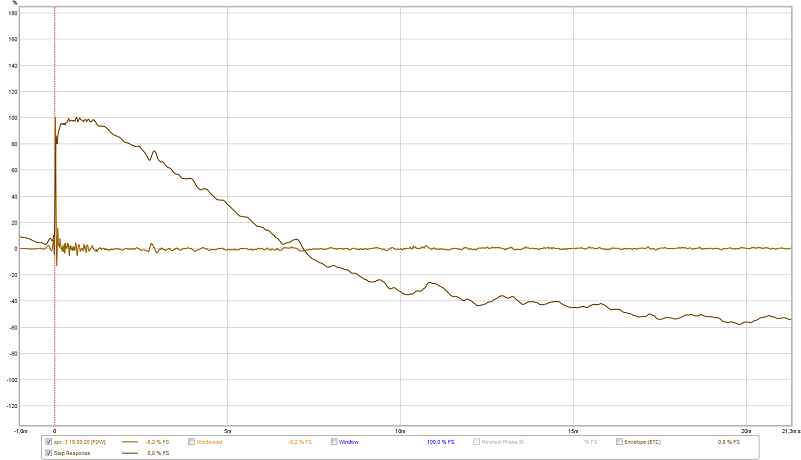
 ...where mine data is with nose into mono speaker at 50 cm but in reality had since that measurement added bit IRR system high pass to widen and relaxe sound quality over all genre, inspiration that its important to educate for better acoustics understanding is great within this thread.
...where mine data is with nose into mono speaker at 50 cm but in reality had since that measurement added bit IRR system high pass to widen and relaxe sound quality over all genre, inspiration that its important to educate for better acoustics understanding is great within this thread.50 x TC9FD18-08 line array:

FAST 10F/8424_SPH-250KE:
Attachments
I'm not sure if I can agree with that, you can have very powerful strokes on the low end and have them loud, if their timing is right. Look at my APL plot, there's not much overhang in the bass at all. Still it's playing the notes from 30 to 50 Hz 6 dB louder than at 2 KHz.
Too much mid bass muddies up the sound, just a hint of it makes it warmer (the way I like it). If you stand outside my house you hear the whole spectrum, not just a bunch of heavy low notes. Nothing stands out.
Take the plunge and make yourself an APL plot. It will show you your specific bass timing. It will also show you if there's any overhang.
Fast bass doesn't need to be lower SPL.
Bass timing and it being slow or fast are two totally different things. Overhang is a third thing. By definition bass frequencies will be "slower" than high frequencies. 50 cycles per second is slower than 2000 cycles per second. Bass has to have some boom and overhang. Have you ever heard a timpani that was "fast"? Fast just means there are more high frequencies in the sound.
What you don't want is your room to add to the overhang. That is what people are after when they install bass traps. It is in the hope of taking out resonances sustained by the room because of room dimensions.
But otherwise, you want your speakers to faithfully reproduce the boom. On my system, a timpani strike sounds satisfyingly boomy. Does that mean my bass is "slow?" No, that is just how a timpani sounds. The dull thud on "Take the power back" on Rage Against the Machine sounds like a dull thud. It is neither fast nor slow.
When I had full range drivers, I used to like "fast" bass also. Mainly because my full rangers did not produce much bass, and it sounded so fast
Whether it is 50 TC9 cones or a two 18" cones, whatever you pick, they have to move at the same rates to produce a given frequency. They cannot move faster or slower than that; if they did, they would produce a different frequency. Of course, how fast the cones need to move also depends on how much cone area there is and how much SPL you are trying to play (I can't remember the relationship between SPL and cone velocity and acceleration...). Now greater cone area means less displacement and that means much lower distortion. It is not unlikely that the Vifas are uncomfortable doing stuff below 50 Hz even though there is 50 of them. Maybe they are. Distortion measurements would tell their story.
Bass timing... yeah, maybe it is audible. Maybe not. I have tried to time align my subs. The DRC filter delay turned out to be different for each of the two subs I have, and plus they are at different distances away from the listening position compared to the arrays. Getting rid of massive delays on the order of a few hundred ms was definitely audible. But between 17 ms and 20 ms, unlikely to be audible because the bass frequencies themselves are so long in time.
I think what you mean by bass timing is the meaning of bass notes in relation to the rest of the music. I would say this is more a function of level than timing. If you're using DRC, it will properly EQ the bass and that is a huge, huge difference. Of course, it only works at one position, but still it is huge.
Sometimes we like to measure and correct something and then we think we hear a difference. I have fallen in that trap many times. Often I've thought the difference was night and day when there really was no difference in place. I've learned to test things somewhat blind to remove the positive bias I might have. It is very easy to believe that if I measure an improvement, the sound also improved.
Last edited:
John Murphy argues that slow bass = late bass. Group delay is the cause of the illusion of slow bass.
https://www.trueaudio.com/post_010.htm
https://www.trueaudio.com/post_011.htm
https://www.trueaudio.com/post_010.htm
https://www.trueaudio.com/post_011.htm
Bass timing and it being slow or fast are two totally different things. Overhang is a third thing. By definition bass frequencies will be "slower" than high frequencies. 50 cycles per second is slower than 2000 cycles per second. Bass has to have some boom and overhang. Have you ever heard a timpani that was "fast"? Fast just means there are more high frequencies in the sound.
No argument there. I've said it myself, many times in fact.
What you don't want is your room to add to the overhang. That is what people are after when they install bass traps. It is in the hope of taking out resonances sustained by the room because of room dimensions.
Don't hope, measure it...
But otherwise, you want your speakers to faithfully reproduce the boom. On my system, a timpani strike sounds satisfyingly boomy. Does that mean my bass is "slow?" No, that is just how a timpani sounds. The dull thud on "Take the power back" on Rage Against the Machine sounds like a dull thud. It is neither fast nor slow.
And still I'm saying it can be high SPL in the low end without "sounding slow".
When I had full range drivers, I used to like "fast" bass also. Mainly because my full rangers did not produce much bass, and it sounded so fastIf you do the experiment I mentioned in the previous post you'll know what I'm talking about (just add >500 Hz back into your signal and listen to the tempo getting perceptually faster).
No thanks, I have output down to 17 Hz, controlled output without overhang. I've heard it uncontrolled and controlled. There's the difference I was after.
Whether it is 50 TC9 cones or a two 18" cones, whatever you pick, they have to move at the same rates to produce a given frequency. They cannot move faster or slower than that; if they did, they would produce a different frequency. Of course, how fast the cones need to move also depends on how much cone area there is and how much SPL you are trying to play (I can't remember the relationship between SPL and cone velocity and acceleration...). Now greater cone area means less displacement and that means much lower distortion. It is not unlikely that the Vifas are uncomfortable doing stuff below 50 Hz even though there is 50 of them. Maybe they are. Distortion measurements would tell their story.
Many distortion measurements were posted in this thread, down to 20 Hz. I'm not going to repost, you see them getting cleaner over time. Once I removed the real low stuff (below 10 Hz) my cones do flap a lot less though.
Bass timing... yeah, maybe it is audible. Maybe not. I have tried to time align my subs. The DRC filter delay turned out to be different for each of the two subs I have, and plus they are at different distances away from the listening position compared to the arrays. Getting rid of massive delays on the order of a few hundred ms was definitely audible. But between 17 ms and 20 ms, unlikely to be audible because the bass frequencies themselves are so long in time.
Finally we made it to the important parts. Just download APL-TDA plus it's requirements and show it. That will proof if it's evenly loaded and timed out in the room. That was my question.
I think what you mean by bass timing is the meaning of bass notes in relation to the rest of the music. I would say this is more a function of level than timing. If you're using DRC, it will properly EQ the bass and that is a huge, huge difference. Of course, it only works at one position, but still it is huge.
Where did we get to the notion it only works in one spot? Here's my old couch sweep which led me to do something extra in damping between 200 Hz and 2 KHz. This is both speakers playing and measured at 7 different positions along my listening area. (about 30 cm apart along the couch)

Now repeat that with a pair of subs.
Sometimes we like to measure and correct something and then we think we hear a difference. I have fallen in that trap many times. Often I've thought the difference was night and day when there really was no difference in place. I've learned to test things somewhat blind to remove the positive bias I might have. It is very easy to believe that if I measure an improvement, the sound also improved.
Duh... I've fallen into that trap and openly admitted as much. But this isn't one of those cases.
Let's see, here's the original signal that goes trough the DAC:

In other word: as fast as the bass can be
Here it is played in my room at the listening position:

Almost as fast with a delay in the lowest octave, better seen in a 2D plot:

This is what I call fast bass, loud and clear.
- Home
- Loudspeakers
- Full Range
- The making of: The Two Towers (a 25 driver Full Range line array)
